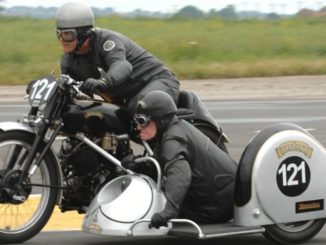Although we moved from Yorkshire to the South Coast 38 years ago and despite living only two miles from his premises in New Milton, I had only once previously visited Sammy Miller’s wonderful motorcycle museum maybe ten years ago when my brother who is a keen Kawazaki 1200 owner was visiting us.
I have always been interested in motorcycles but have only ever owned one, a 1955 BSA C11G 250 that I bought in 1963 for £30; not the most exciting machine but one that taught me many valuable lessons about vehicle maintenance that have held me in good stead over the years. My dream bike as a kid was always a Velocette Venom 500cc single but, alas, I never owned one as, back in the late 1960s my best mate, who was home for the weekend from nautical college, had an accident in town on his bike and was killed. That put me off bikes so from then onward it was four wheels or nothing for me.
Nevertheless, like my passion for ancient firearms, I am fascinated by the history, development and engineering of motorcycles so, when my granddaughter’s boyfriend casually mentioned that he liked bikes but knew nothing about them, I immediately suggested that we visit the museum together.
For those who may be not be familiar with the name Sammy Miller, according to Wikipedia:
“After attending his first race at the age of 16 in 1951, Miller followed a career involving both road, dirt/grass track racing and observed trials. Miller became British Trials Champion 11 times and won the European Trials Championship twice. In his continuing career, Miller is a winner of over 1300 trials, nine gold medals and the International Six Days Trial, three victories at the North West 200, as well as coming 3rd in the 1957 250cc Grand Prix in championship. In racing he rode a variety of machines including AJS 7R, Mondial and NSU, he has won three 250cc North West 200 events (1956-1958).
Miller rode mainly Ariel motorcycles, including both trials events and the Isle of Man TT races. When Ariel were absorbed by BSA in 1964, he formed a partnership with a Spanish firm, Bultaco, and went on to become the lead developer of modern two-stroke trials motorcycles. The bike he created was the Sherpa T. This was done in 12 days, realizing his success when he finally cleaned a section on the Sherpa that was uncleanable on his famous Ariel. In his later professional racing career, Miller was involved with Honda.
Miller is best known for the 500cc Ariel HT5 that he lightened considerably from standard ex-factory condition. The bike was famously known by its UK registration mark, GOV 132. It is now an exhibit in the Sammy Miller Museum (see below).
Miller parted from Ariel at the end of 1964, moving to Bultaco motorcycles, then newly imported by the Rickman brothers, a press photo-call with Ariel executive Ken Whistance and competition manager Ernie Smith ending his seven years of association.
During the 1960s he won the Scott Trial six times, twice on an Ariel and four times on a Bultaco.
He set up his own motorcycle parts business in 1964 in New Milton, Hampshire, and put a few of his old racing motorcycles in the corner, later to become the Sammy Miller Motorcycle museum. In 2007 he was inducted into the AMA Motorcycle Hall of Fame. He sold his parts business as Sammy Miller Products in 2007.
Today, Miller still rides in demonstration events”.
Sammy’s museum is situated on the outskirts of New Milton in the New Forest and the exhibits are displayed in a series of themed halls built on two storeys. In the courtyard outside the entrance there is a tea room/cafeteria, a children’s play area and craft and gift shops.
I don’t claim to have any expertise regarding motorcycles other than a nostalgic appreciation of their beauty and functionality so the pictures I took reflect my personal memories and interests. I’ll let the pictures do most of the talking.

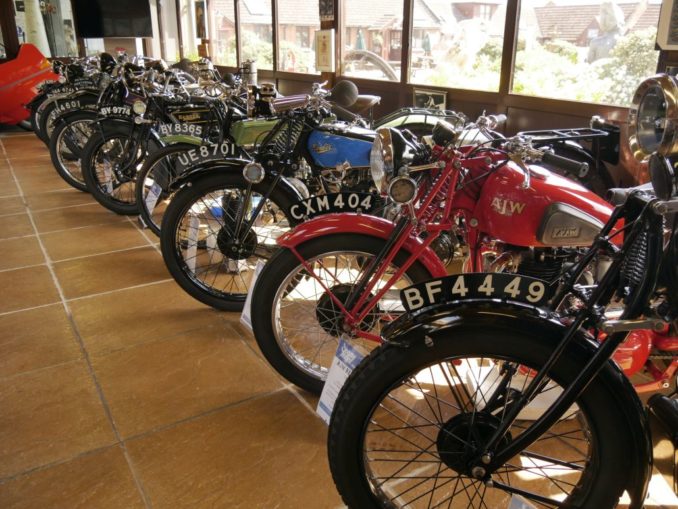
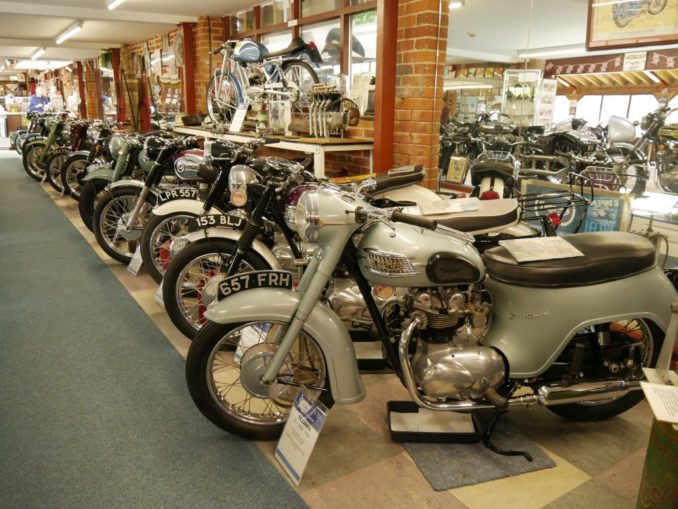
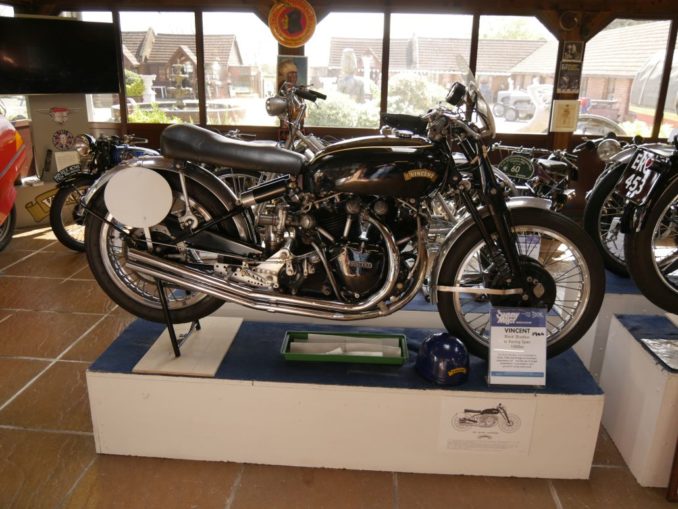
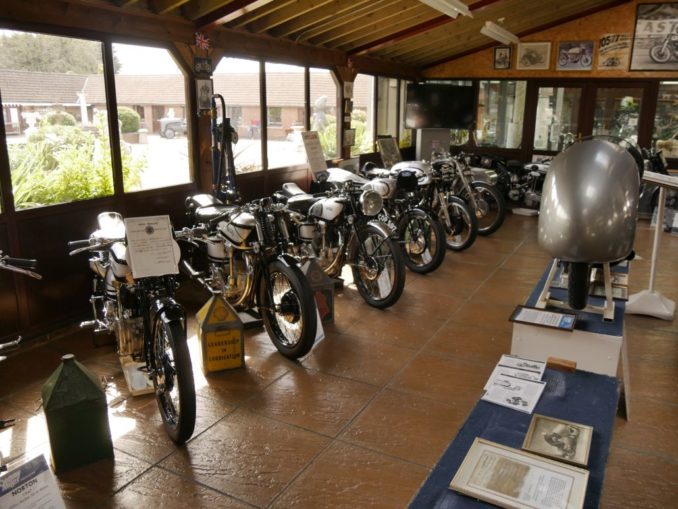
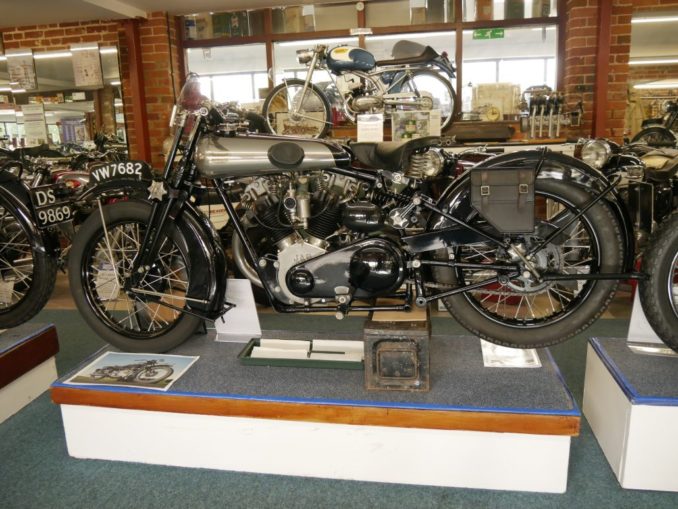

I remember as a youth reading Lawrence’s exciting description of his race with a biplane in 1925 as he hurtled up the A15 from Cranwell towards Lincoln in search of the makings of a fry-up while serving in the RAF as Aircraftman Shaw. Here it is for your pleasure; I hope it moves you as it did me more than 50 years ago.
“The extravagance in which my surplus emotion expressed itself lay on the road. So long as roads were tarred blue and straight; not hedged; and empty and dry, so long I was rich.
Nightly I’d run up from the hangar, upon the last stroke of work, spurring my tired feet to be nimble. The very movement refreshed them, after the day-long restraint of service. In five minutes my bed would be down, ready for the night: in four more I was in breeches and puttees, pulling on my gauntlets as I walked over to my bike, which lived in a garage-hut, opposite. Its tyres never wanted air, its engine had a habit of starting at second kick: a good habit, for only by frantic plunges upon the starting pedal could my puny weight force the engine over the seven atmospheres of its compression.
Boanerges’ first glad roar at being alive again nightly jarred the huts of Cadet College into life. ‘There he goes, the noisy bugger,’ someone would say enviously in every flight. It is part of an airman’s profession to be knowing with engines: and a thoroughbred engine is our undying satisfaction. The camp wore the virtue of my Brough like a flower in its cap. Tonight Tug and Dusty came to the step of our hut to see me off. ‘Running down to Smoke, perhaps?’ jeered Dusty; hitting at my regular game of London and back for tea on fine Wednesday afternoons.
Boa is a top-gear machine, as sweet in that as most single-cylinders in middle. I chug lordlily past the guard-room and through the speed limit at no more than sixteen. Round the bend, past the farm, and the way straightens. Now for it. The engine’s final development is fifty-two horse-power. A miracle that all this docile strength waits behind one tiny lever for the pleasure of my hand.
Another bend: and I have the honour of one of England’ straightest and fastest roads. The burble of my exhaust unwound like a long cord behind me. Soon my speed snapped it, and I heard only the cry of the wind which my battering head split and fended aside. The cry rose with my speed to a shriek: while the air’s coldness streamed like two jets of iced water into my dissolving eyes. I screwed them to slits, and focused my sight two hundred yards ahead of me on the empty mosaic of the tar’s gravelled undulations.
Like arrows the tiny flies pricked my cheeks: and sometimes a heavier body, some house-fly or beetle, would crash into face or lips like a spent bullet. A glance at the speedometer: seventy-eight. Boanerges is warming up. I pull the throttle right open, on the top of the slope, and we swoop flying across the dip, and up-down up-down the switchback beyond: the weighty machine launching itself like a projectile with a whirr of wheels into the air at the take-off of each rise, to land lurchingly with such a snatch of the driving chain as jerks my spine like a rictus.
Once we so fled across the evening light, with the yellow sun on my left, when a huge shadow roared just overhead. A Bristol Fighter, from Whitewash Villas, our neighbour aerodrome, was banking sharply round. I checked speed an instant to wave: and the slip-stream of my impetus snapped my arm and elbow astern, like a raised flail. The pilot pointed down the road towards Lincoln. I sat hard in the saddle, folded back my ears and went away after him, like a dog after a hare. Quickly we drew abreast, as the impulse of his dive to my level exhausted itself.
The next mile of road was rough. I braced my feet into the rests, thrust with my arms, and clenched my knees on the tank till its rubber grips goggled under my thighs. Over the first pot-hole Boanerges screamed in surprise, its mud-guard bottoming with a yawp upon the tyre. Through the plunges of the next ten seconds I clung on, wedging my gloved hand in the throttle lever so that no bump should close it and spoil our speed. Then the bicycle wrenched sideways into three long ruts: it swayed dizzily, wagging its tail for thirty awful yards. Out came the clutch, the engine raced freely: Boa checked and straightened his head with a shake, as a Brough should.
The bad ground was passed and on the new road our flight became birdlike. My head was blown out with air so that my ears had failed and we seemed to whirl soundlessly between the sun-gilt stubble fields. I dared, on a rise, to slow imperceptibly and glance sideways into the sky. There the Bif was, two hundred yards and more back. Play with the fellow? Why not? I slowed to ninety: signalled with my hand for him to overtake. Slowed ten more: sat up. Over he rattled. His passenger, a helmeted and goggled grin, hung out of the cock-pit to pass me the ‘Up yer’ Raf randy greeting.
They were hoping I was a flash in the pan, giving them best. Open went my throttle again. Boa crept level, fifty feet below: held them: sailed ahead into the clean and lonely country. An approaching car pulled nearly into its ditch at the sight of our race. The Bif was zooming among the trees and telegraph poles, with my scurrying spot only eighty yards ahead. I gained though, gained steadily: was perhaps five miles an hour the faster. Down went my left hand to give the engine two extra dollops of oil, for fear that something was running hot: but an overhead JAP twin, super-tuned like this one, would carry on to the moon and back, unfaltering.
We drew near the settlement. A long mile before the first houses I closed down and coasted to the cross-roads by the hospital. Bif caught up, banked, climbed and turned for home, waving to me as long as he was in sight. Fourteen miles from camp, we are, here: and fifteen minutes since I left Tug and Dusty at the hut door.
I let in the clutch again, and eased Boanerges down the hill along the tram-lines through the dirty streets and up-hill to the aloof cathedral, where it stood in frigid perfection above the cowering close. No message of mercy in Lincoln. Our God is a jealous God: and man’s very best offering will fall disdainfully short of worthiness, in the sight of Saint Hugh and his angels.
Remigius, earthy old Remigius, looks with more charity on and Boanerges. I stabled the steel magnificence of strength and speed at his west door and went in: to find the organist practising something slow and rhythmical, like a multiplication table in notes on the organ. The fretted, unsatisfying and unsatisfied lace-work of choir screen and spandrels drank in the main sound. Its surplus spilled thoughtfully into my ears.
By then my belly had forgotten its lunch, my eyes smarted and streamed. Out again, to sluice my head under the White Hart’s yard-pump. A cup of real chocolate and a muffin at the teashop: and Boa and I took the Newark road for the last hour of daylight. He ambles at forty-five and when roaring his utmost, surpasses the hundred. A skittish motor-bike with a touch of blood in it is better than all the riding animals on earth, because of its logical extension of our faculties, and the hint, the provocation, to excess conferred by its honeyed untiring smoothness. Because Boa loves me, he gives me five more miles of speed than a stranger would get from him.
At Nottingham I added sausages from my wholesaler to the bacon which I’d bought at Lincoln: bacon so nicely sliced that each rasher meant a penny. The solid pannier-bags behind the saddle took all this and at my next stop a (farm) took also a felt-hammocked box of fifteen eggs. Home by Sleaford, our squalid, purse-proud, local village. Its butcher had six penn’orth of dripping ready for me. For months have I been making my evening round a marketing, twice a week, riding a hundred miles for the joy of it and picking up the best food cheapest, over half the country side.”
After his exploits in Arabia during WWI, Lawrence found it difficult to readjust to civilian life and in order to achieve anonymity while writing ‘The Seven Pillars of Wisdom’ enlisted in the RAF in 1922 as Aircraftman TE Ross. Due to press publicity ‘Ross’ was dismissed from the RAF in 1923 the following month joining the Army Tank Corps as Private TE Shaw and serving at Bovington Camp in Dorset where he bought ‘Clouds Hill’ cottage. In August 1925 Aircraftman ‘Shaw’ rejoined the RAF and was posted to Cranwell College. He completed ‘The Mint’ in 1928 while stationed in India. It was published posthumously in 1955.
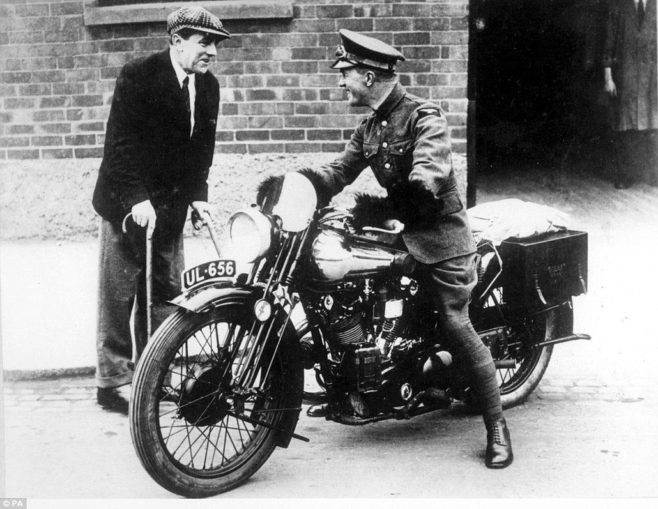
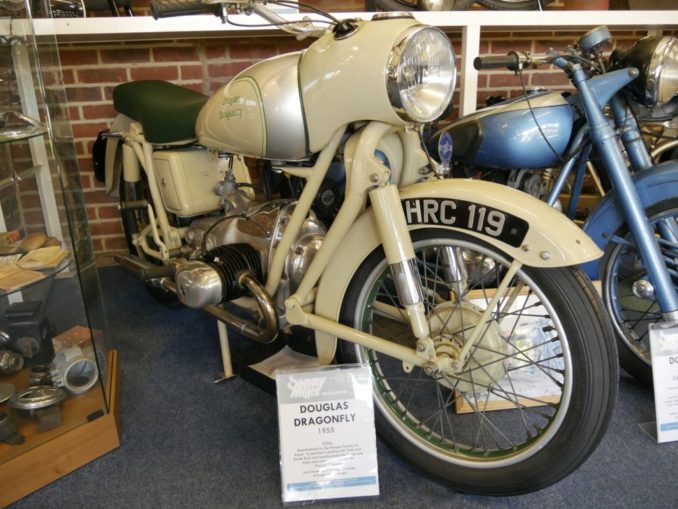
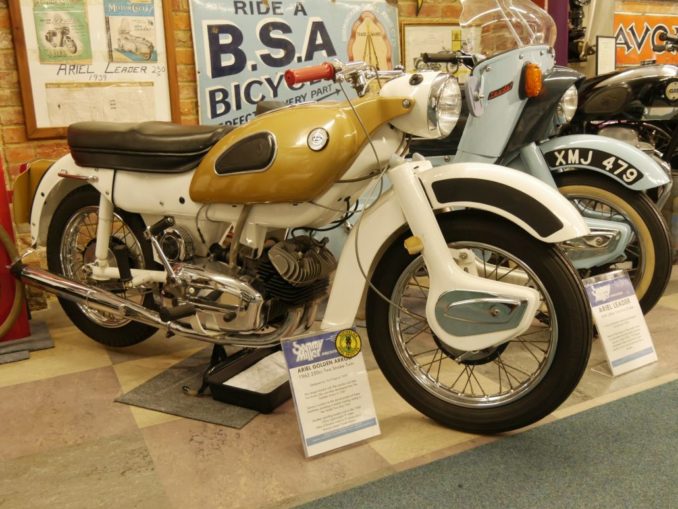

The highlight of our visit came when a softly spoken, gentleman with an Irish accent came up to us and asked us if we’d come far. It was Mr Miller himself and what an honour it was to shake his hand. It’s not every day that you meet a legend in his own lifetime.
Which bike would I like to have taken home? It’s impossible to say as there were so many interesting and beautifully restored motorcycles from which to choose but I was very much attracted to this one which in my opinion is absolutely stunning.
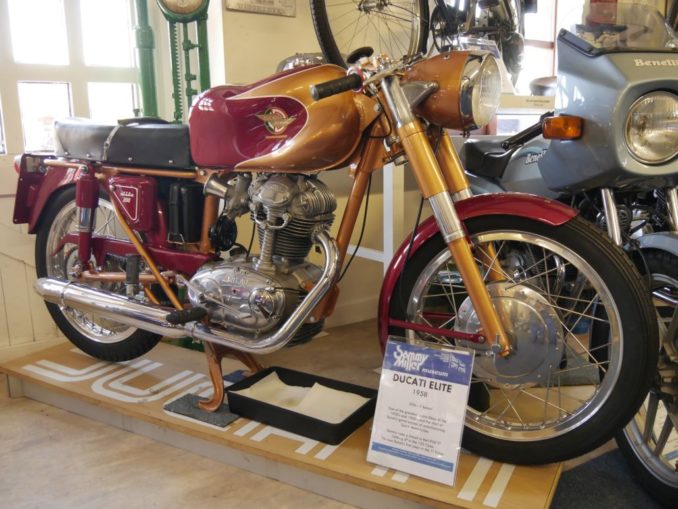
All in all, it was a wonderful afternoon out and excellent value for the £9 admission fee. If you do find yourself in the New Forest area with a few hours to spare, I can thoroughly recommend a trip to Mr Miller’s most excellent museum. You won’t be disappointed.
Sammy Miller’s Motorcycle Museum
© Tom Pudding 2019
The Goodnight Vienna Audio file



